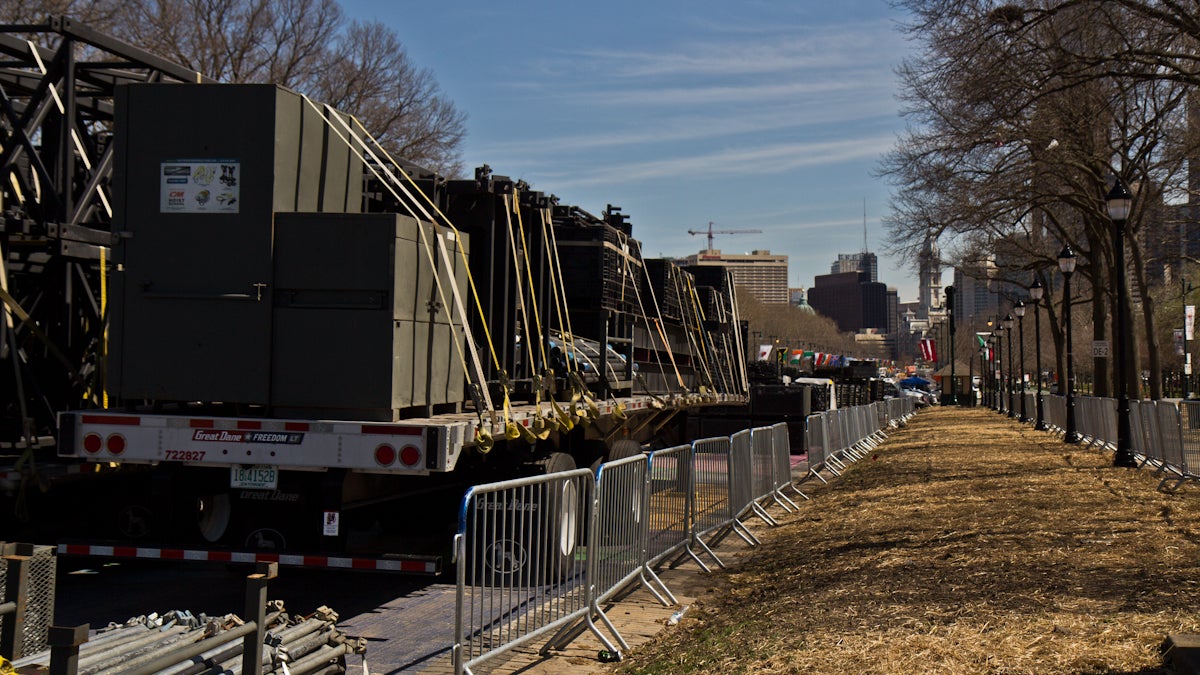NFL Draft turns Parkway into privatized ‘brandscape’ and backdrop

By now you’ve heard about or experienced the inconvenient road closures around the Benjamin Franklin Parkway thanks to the NFL Draft. It’s a hassle. But that’s not what Community Contributor Kevin Rossi is most concerned about. It’s the perpetual uptick of the Parkway’s public spaces being turned into private, corporately controlled spaces for special events and the top-down manner in which those decisions are made.
The Benjamin Franklin Parkway has long been a go-to site for hosting major events in Philadelphia. From Pope Francis’ visit in 2015 to the annual Made in America festival and Wawa Welcome America Fourth of July concert to the myriad marathons and charitable events taking place each year, the Parkway and Philadelphia Museum of Art area provide a uniquely Philly backdrop.
However, each with their own road closures, parking restrictions and general inconveniences, any one of the 25 or so events each year on the Parkway could invoke frustrations for residents and businesses in the area, but the 2017 NFL Draft has been an entirely new nightmare. When the dust settles, construction and breakdown of a temporary theater on the Art Museum steps and accompanying fan festival for the three-day event beginning Thursday will have lasted nearly one month.
These well-documented inconveniences are symptoms of a larger issue: transferring public space to private control. As the number of events held annually on the Parkway continues to grow (along with the physical footprint of some events) it is critical for Philadelphians to discuss how they want public spaces utilized.
The actual draft will take place in a grandiose, temporary 3,000-seat theater constructed for the event, where NFL executives will announce each selection on-stage; there are limited tickets available each day. But this is where the NFL Draft Experience presented by Dannon® Oikos® Triple Zero comes into play. At the free fan fest, which the league boasts as “the largest festival footprint ever created by the NFL, spanning the size of nearly twenty-five football fields, “fans will be able to “participate in interactive exhibits, immersive games, and virtual reality experiences, free player autograph sessions and more.”
If the full name of the event didn’t already give away the point, an event that is “free and open to the public” is not operating in public space when it is under private control. English urban space scholars David McGillivray and Matt Frew discussed this idea in a 2014 paper studying the use of secondary live event sites, like fan fests and viewing parties, during the 2012 Summer Olympics in London. They argue that transferring public space to private control for the sake of a sporting event, provides corporate interests two crucial elements: controlled grounds for commercialization and security.
Despite being free, the NFL Draft Experience still performs the same function McGillivray and Frew describe: to “encourage audiences to perform festivity and participate in experiential consumption” in a “brandscaped” environment – in other words, buy stuff while getting bombarded with sponsor messages. When the Parkway is temporarily transformed into a space for mass consumption and away from its public space and transportation functions, it turns citizens into consumers. McGillivray and Frew write that these commercialized environments are “carefully planned, orchestrated and mediated events, designed to produce very specific outcomes for host cities,” a fact which has been all too plain as the city and league tout a projected economic impact of $80 million, although it will likely be less. With so much at stake for the NFL, city, and sponsors – not to mention players and teams – securing the area is a critical step to ensure order and, of course, seamless consumption.
It is also worth noting that a state- and city-funded sports complex designed for such mass consumption and security exists just a short drive down I-76. But the NFL had no interest in any other area, instead choosing the spectacle, noting that the Parkway allows for “incorporating famed city landmarks spanning from Philadelphia City Hall to the iconic steps of the Philadelphia Museum of Art.”
Looming over this discussion is the top-down manner in which the decisions on Parkway space utilization are made. Instead of incorporating residents, neighborhood associations and local businesses into deciding which events make sense for their area, the city has handed down announcements and mitigated obstacles. Voicing displeasure about traffic, parking restrictions and other inconveniences is useful, and to its credit, the city has vowed to meet with people in the area this fall.
Reframing the issue as the privatization of public space, though, will help citizens get to the heart of the issue and create a vision for how they want to see the Parkway and other spaces throughout Philadelphia utilized – for the public good.

WHYY is your source for fact-based, in-depth journalism and information. As a nonprofit organization, we rely on financial support from readers like you. Please give today.




